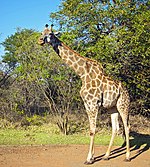
The giraffe is a large African hoofed mammal belonging to the genus Giraffa. It is the tallest living terrestrial animal and the largest ruminant on Earth. Traditionally, giraffes were thought to be one species, Giraffa camelopardalis, with nine subspecies. Most recently, researchers proposed dividing them into up to eight extant species due to new research into their mitochondrial and nuclear DNA, as well as morphological measurements. Seven other extinct species of Giraffa are known from the fossil record.

The Giraffidae are a family of ruminant artiodactyl mammals that share a common ancestor with deer and bovids. This family, once a diverse group spread throughout Eurasia and Africa, presently comprises only two extant genera, the giraffe and the okapi. Both are confined to sub-Saharan Africa: the giraffe to the open savannas, and the okapi to the dense rainforest of the Congo. The two genera look very different on first sight, but share a number of common features, including a long, dark-coloured tongue, lobed canine teeth, and horns covered in skin, called ossicones.

The Masai giraffe, also spelled Maasai giraffe, and sometimes called the Kilimanjaro giraffe, is a species or subspecies of giraffe. It is native to East Africa. The Masai giraffe can be found in central and southern Kenya and in Tanzania. It has distinctive jagged, irregular leaf-like blotches that extend from the hooves to its head. The Masai giraffe is currently the national animal of Tanzania.

The northern giraffe, also known as three-horned giraffe, is the type species of giraffe, G. camelopardalis, and is native to North Africa, although alternative taxonomic hypotheses have proposed the northern giraffe as a separate species.

The red-billed oxpecker is a Mutualistic passerine bird in the oxpecker family, Buphagidae. It is native to the savannah of sub-Saharan Africa, from the Central African Republic east to South Sudan and south to northern and eastern South Africa. Its range overlaps that of the less widespread yellow-billed oxpecker.
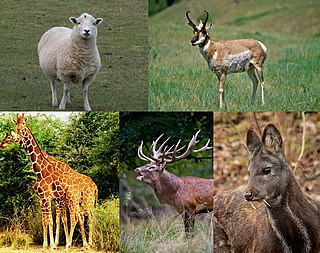
Pecora is an infraorder of even-toed hoofed mammals with ruminant digestion. Most members of Pecora have cranial appendages projecting from their frontal bones; only two extant genera lack them, Hydropotes and Moschus. The name "Pecora" comes from the Latin word pecus, which means "cattle". Although most pecorans have cranial appendages, only some of these are properly called "horns", and many scientists agree that these appendages did not arise from a common ancestor, but instead evolved independently on at least two occasions. Likewise, while Pecora as a group is supported by both molecular and morphological studies, morphological support for interrelationships between pecoran families is disputed.
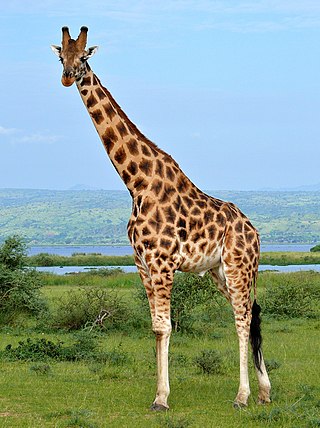
Rothschild's giraffe is a subspecies of the Northern giraffe. It is one of the most endangered distinct populations of giraffe, with 1,399 mature individuals estimated in the wild in 2018.
A genetic isolate is a population of organisms with little genetic mixing with other organisms within the same species due to geographic isolation or other factors that prevent reproduction. Genetic isolates form new species through an evolutionary process known as speciation. All modern species diversity is a product of genetic isolates and evolution.
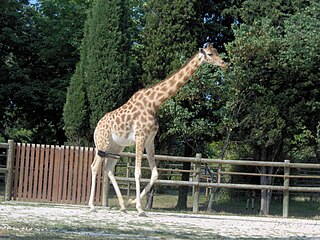
The Kordofan giraffe is a species or subspecies of giraffe found in northern Cameroon, southern Chad, the Central African Republic, and possibly western Sudan. Historically some confusion has existed over the exact range limit of this subspecies compared to the West African giraffe, with populations in e.g. northern Cameroon formerly assigned to the latter. Genetic work has also revealed that all "West African giraffe" in European zoos are in fact Kordofan giraffe. It has been suggested that the Nigerian giraffe's ancestor dispersed from East to North Africa during the Quaternary period and thereafter migrated to its current Sahel distribution in West Africa in response to the development of the Sahara desert. Compared to most other subspecies, the Kordofan giraffe is relatively small at 3.8 to 4.7 meters, with more irregular spots on the inner legs. Its English name is a reference to Kordofan in Sudan. There are around 2,300 individuals living in the wild.
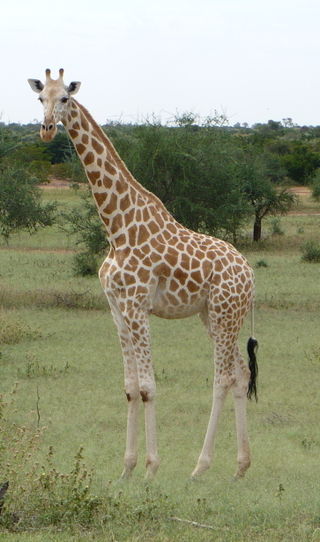
The West African giraffe, also known as the Niger giraffe or Nigerian giraffe, is a species or subspecies of the giraffe distinguished by its light colored spots. It is found in the Sahel of West Africa.
Synodontis camelopardalis, known as the giraffe synodontis, is a species of upside-down catfish that is endemic to the Democratic Republic of the Congo where it is only known to occur in the Tshuapa River. It was first described by Max Poll in 1971. The original specimens were obtained in Eala, on the Ruki River in the central Congo River Basin. The species name camelopardalis refers to the giraffe, Giraffa camelopardalis, in reference to the coloration of the fish.

The South African giraffe or Cape giraffe is a species or subspecies of giraffe found in South Africa, Namibia, Botswana, Zimbabwe, Eswatini and Mozambique. It has rounded or blotched spots, some with star-like extensions on a light tan background, running down to the hooves.

Thornicroft's giraffe, also known as the Rhodesian giraffe or Luangwa giraffe, is a subspecies of giraffe. It is sometimes considered a species in its own right or a subspecies of the Masai giraffe. It is geographically isolated, occurring only in Zambia’s South Luangwa Valley. An estimated 550 live in the wild, with no captive populations. Its lifespan is 22 years for males and 28 years for females. The ecotype was originally named after Harry Scott Thornicroft, a commissioner in what was then North-Eastern Rhodesia and later Northern Rhodesia.

Sexual selection in mammals is a process the study of which started with Charles Darwin's observations concerning sexual selection, including sexual selection in humans, and in other mammals, consisting of male–male competition and mate choice that mold the development of future phenotypes in a population for a given species.
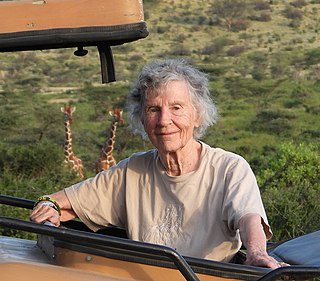
Anne Christine Innis Dagg is a Canadian zoologist, feminist, and author of numerous books. A pioneer in the study of animal behaviour in the wild, Dagg is credited with being the first to study wild giraffes. Her impact on current understandings of giraffe biology and behaviour were the focus of the 2011 CBC radio documentary Wild Journey: The Anne Innis Story the 2018 documentary film The Woman Who Loves Giraffes, and the 2021 children’s book ‘’The Girl Who Loved Giraffes and Became the World’s First Giraffologist’’.
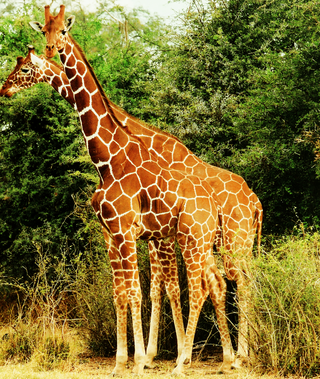
The reticulated giraffe is a species or subspecies of giraffe native to the Horn of Africa. It lives in Somalia, southern Ethiopia, and northern Kenya. There are approximately 8,500 individuals living in the wild.
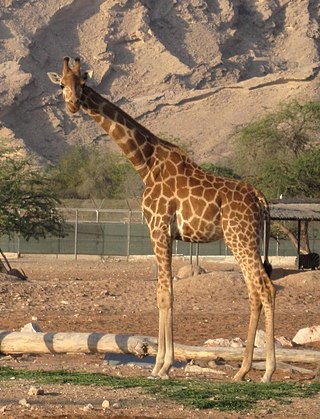
The Nubian giraffe, also known as Baringo giraffe or Ugandan giraffe, is the nominate subspecies or species of giraffe. It is found in Ethiopia, Kenya, Uganda, South Sudan and Sudan. It is currently extinct in the wild of the Democratic Republic of Congo, Egypt and Eritrea. The Nubian giraffe used to be widespread in northeast Africa. The subspecies was listed as Critically Endangered by the IUCN in 2018 for the first time due to a 95% decline in the past three decades.

The Angolan giraffe, also known as the Namibian giraffe or smokey giraffe, is a species or subspecies of giraffe that is found in northern Namibia, south-western Zambia, Botswana, western Zimbabwe and since mid-2023 again in Angola.

Megaherbivores are large terrestrial herbivores that can exceed 1,000 kg (2,200 lb) in weight. This polyphyletic group of megafauna includes elephants, rhinos, hippos, and giraffes. The largest bovids occasionally reach a weight of 1 tonne, but they are generally not considered to be megaherbivores. There are nine extant species of megaherbivores living in Africa and Asia. The African bush elephant is the largest extant species with bulls reaching a height of up to 3.96 m (13.0 ft) and a maximum weight of 10,400 kg (22,900 lb).

